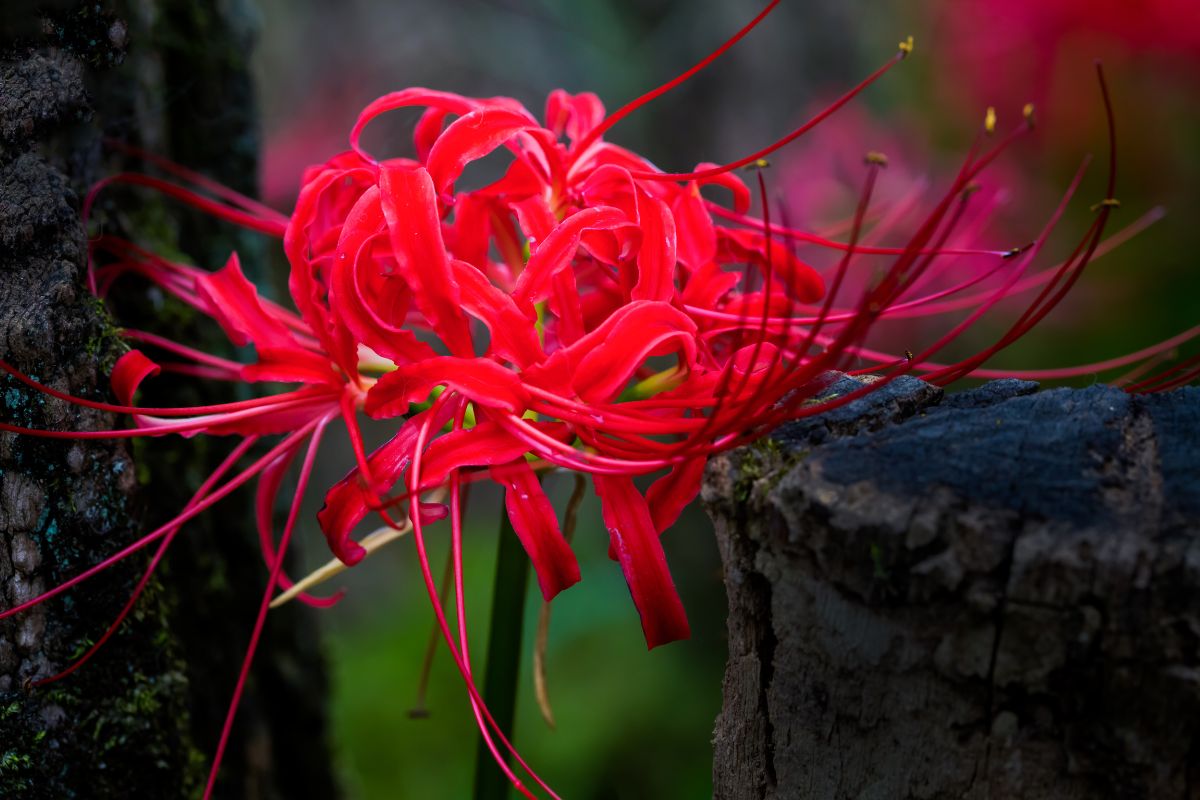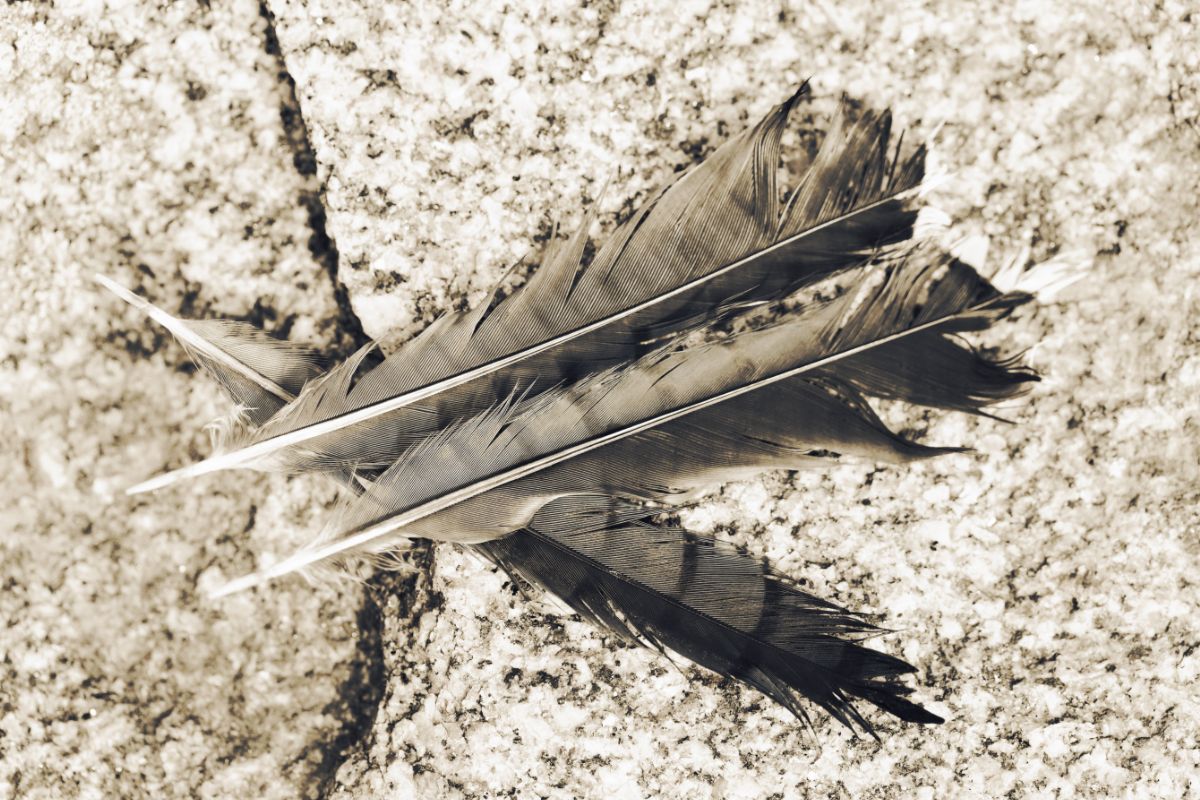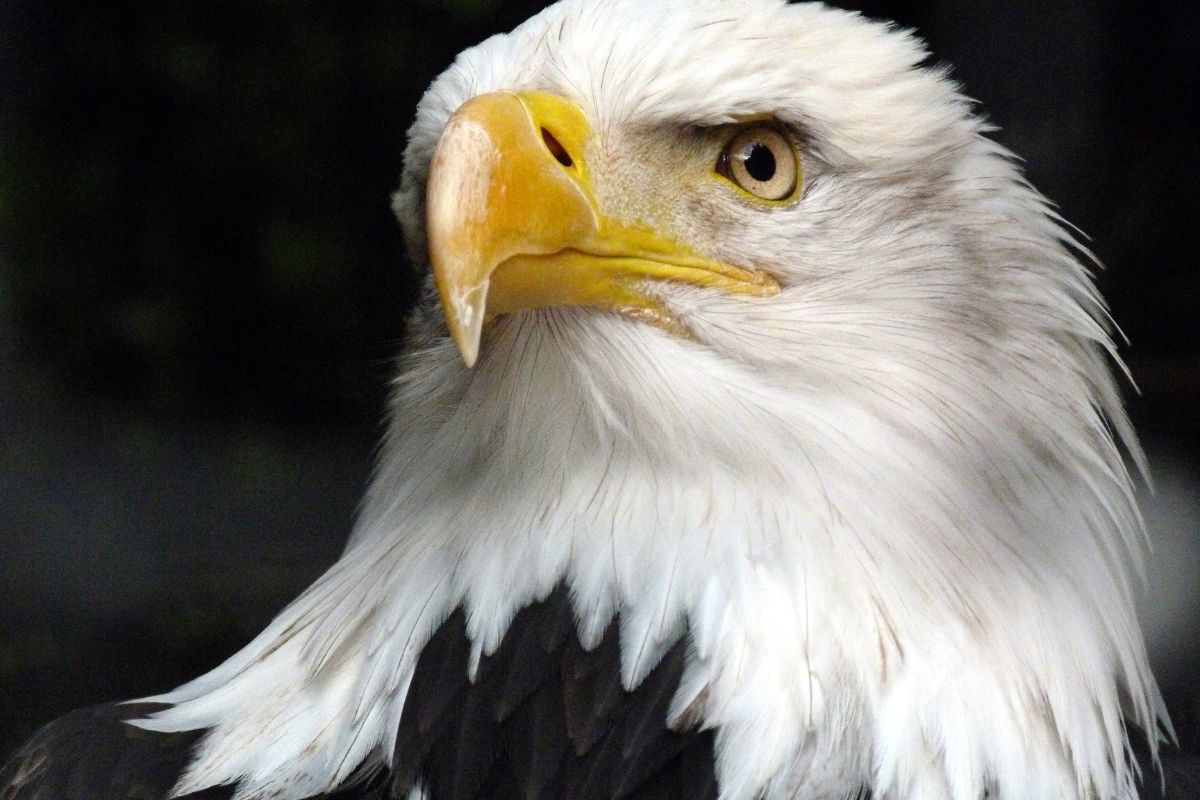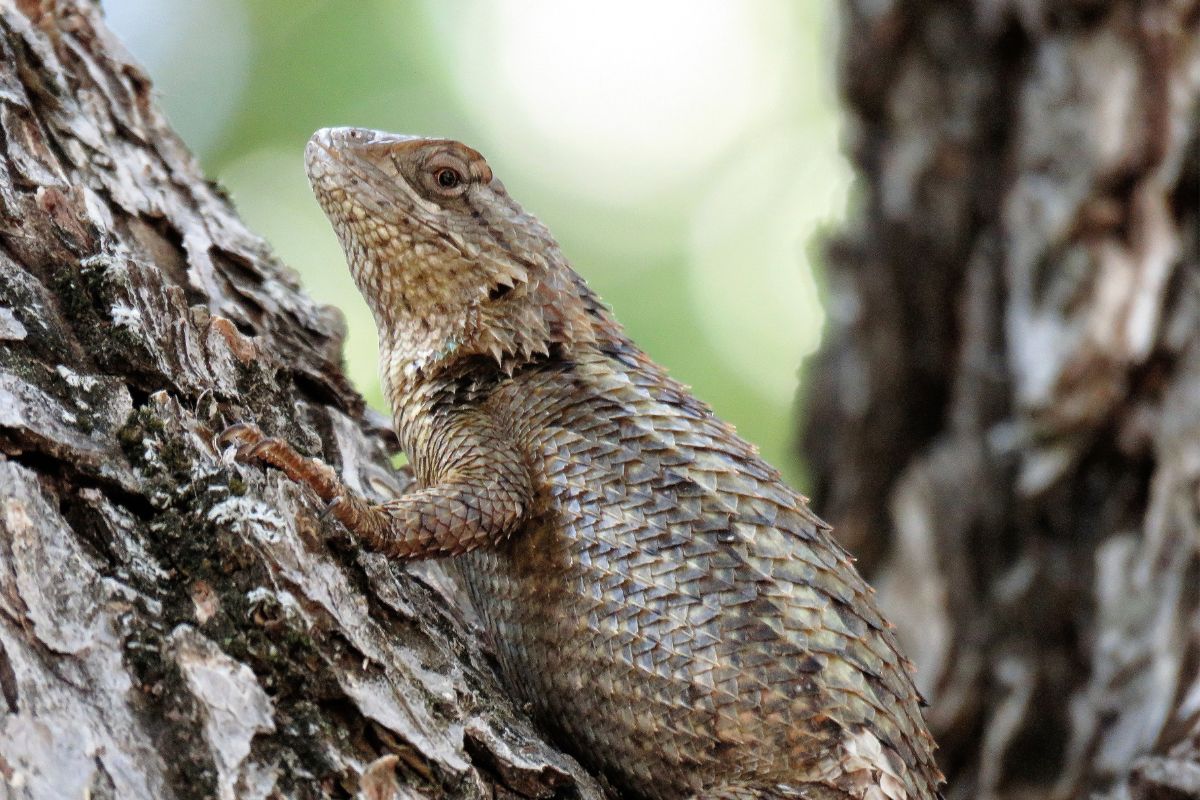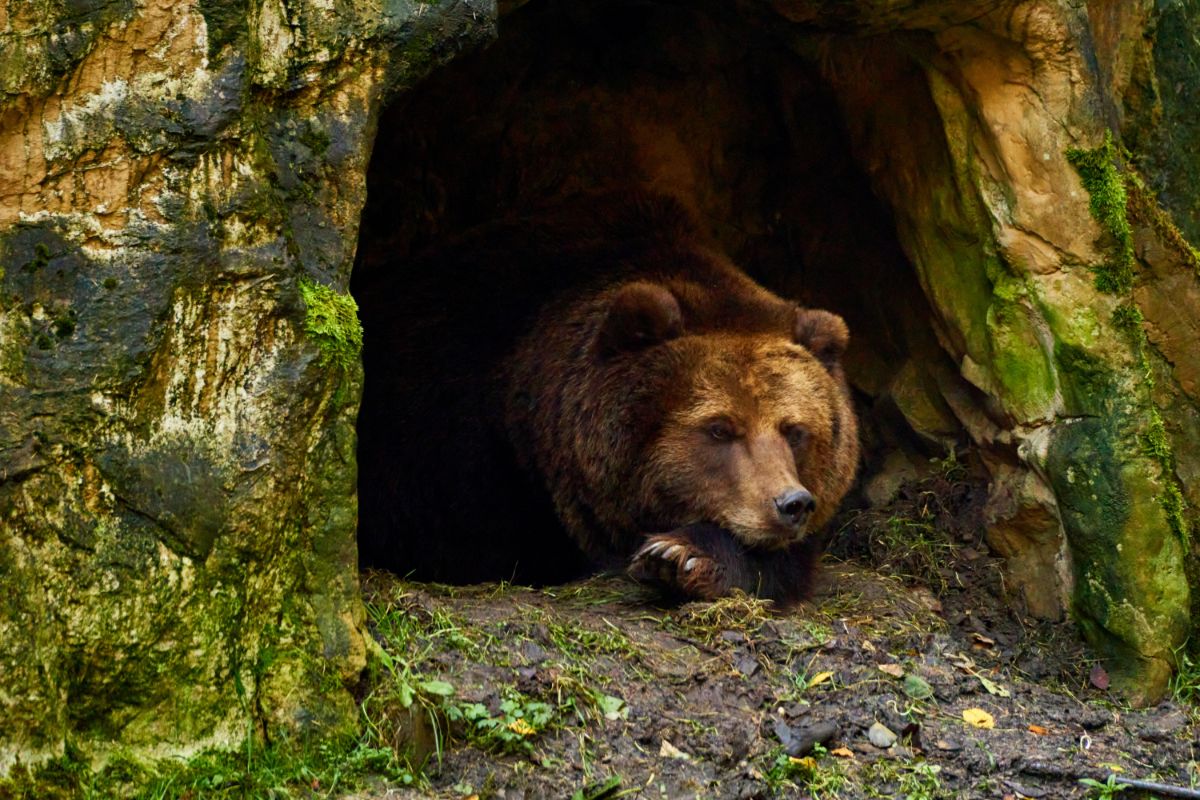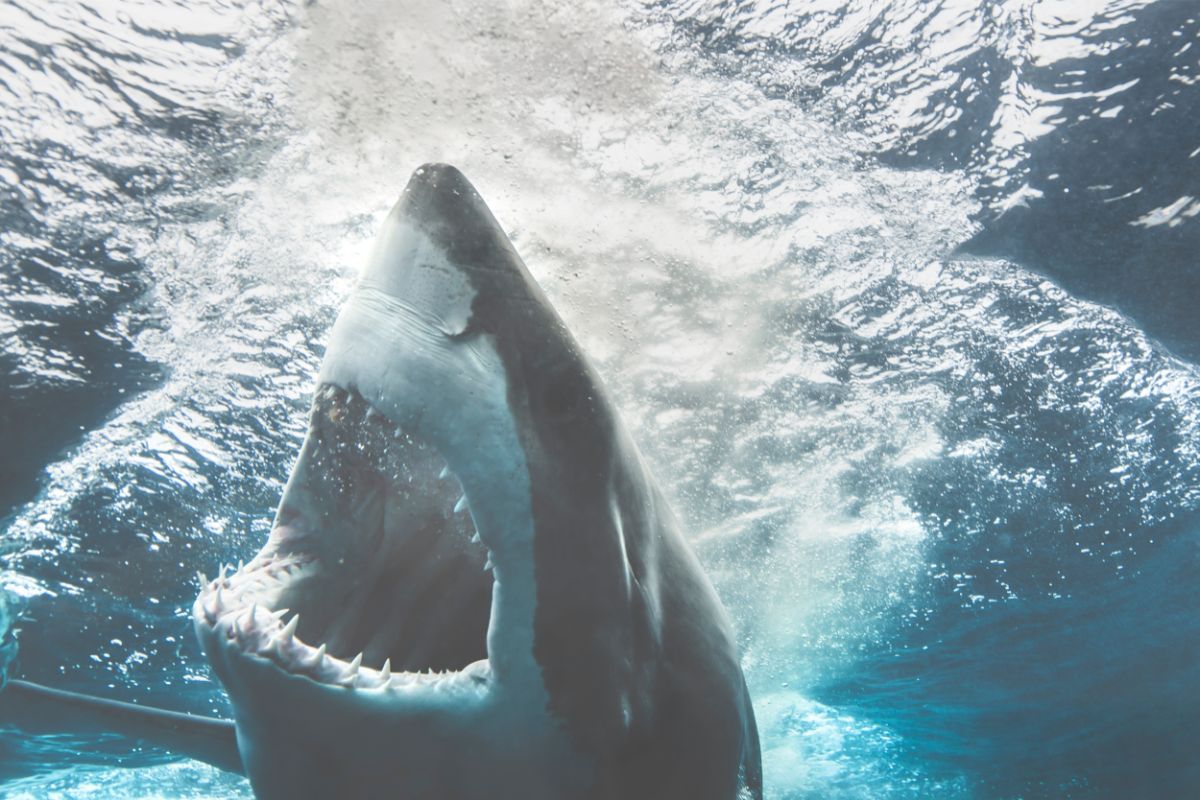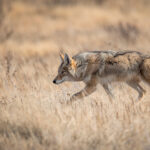
Let’s start by saying that not all of the animals on this list necessarily live in lakes. Some may live along shorelines or just frequent lakes often. The basis of this list is that these are common animals that you are likely to find when visiting lakes. They range from mammals to fish to insects. We compiled the most common ones and gave some interesting information about each. Enjoy!
Here is a quick summary of the list to give you an idea of what you’re about to read.
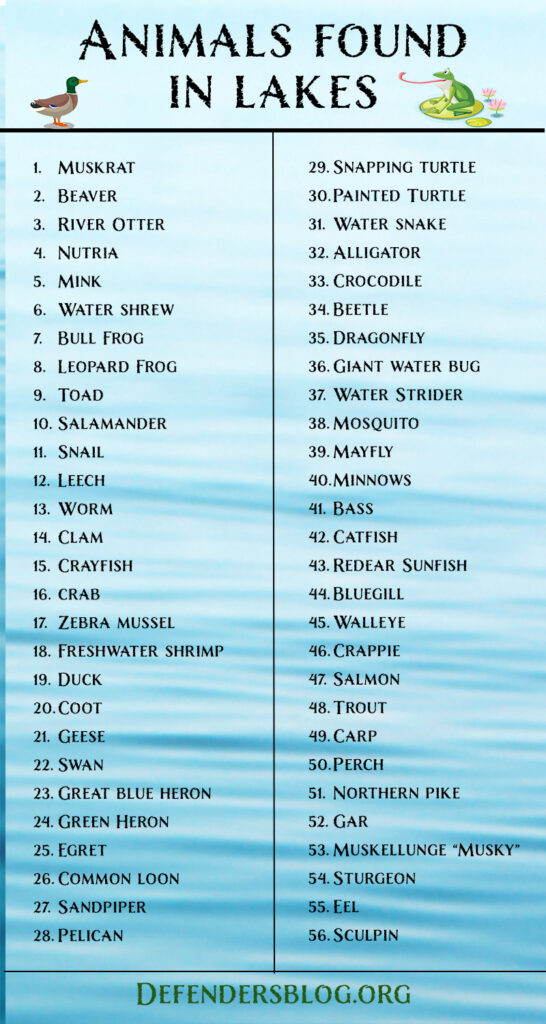
Now lets get some more details on these 56 animals found in lakes!
Muskrat
Muskrats are a semiaquatic rodent that some people mistake for a beaver. Muskrats weigh 2 to 4 pounds and have a rat like tail. They are herbivores eating many different aquatic plants. They typically build their homes out of mud and vegetation or live in burrows.
Beaver
Beavers are large semiaquatic rodents and are the largest rodents in North America. Beavers have large teeth that they use to cut down trees and gnaw branches to build dams and to eat. Beavers also build lodges out of brush and vegetation to live in. Beavers also have a large paddle like tail that will slap the water when threatened. This helps warn others of danger. If you want to learn why beavers build dams and other interesting facts about beavers, check out our article on why beavers build dams.
River Otter
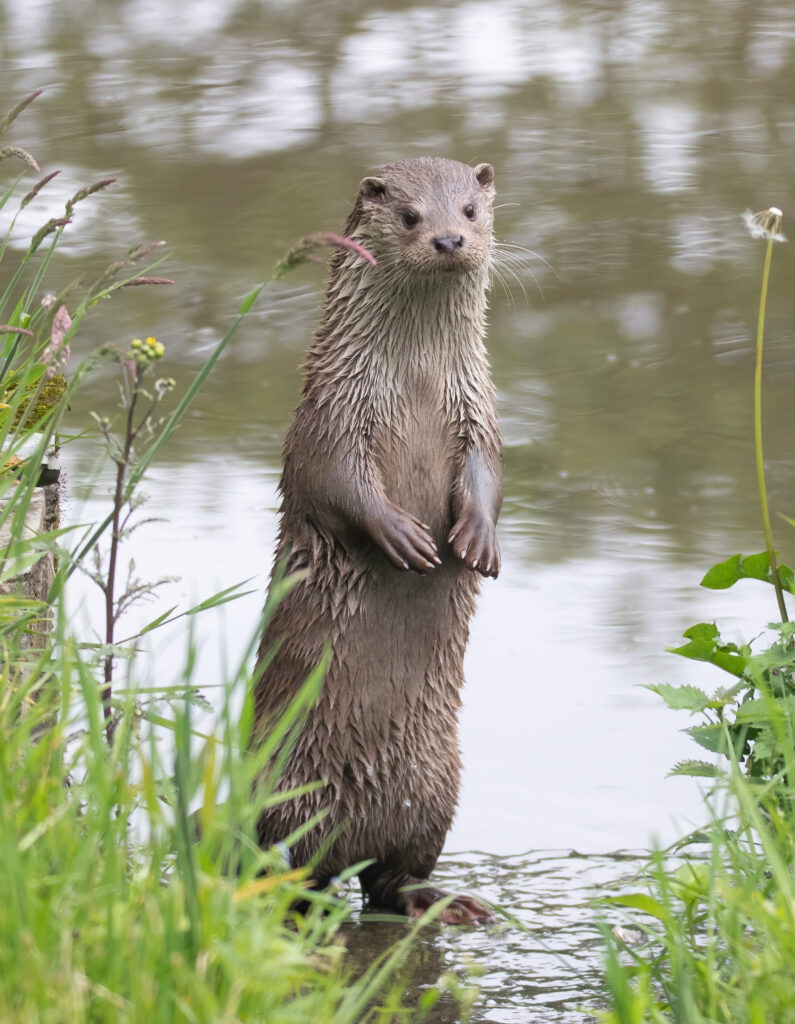
River otters are known to be very playful. They can weigh between 12 and 30 pounds and have a beautiful pelt of fur. They eat a variety of different things including fish, frogs, turtles, and eggs. River otters will live in dens that have an underwater entrance to help protect against predators.
Nutria
Nutria are semiaquatic rodents that typically weigh between 10 and 20 pounds. They are considered a nuisance animal in the United States due to the large population growth and disruption of the native ecosystems since their introduction in the early 1900’s. Nutria have two bright orange front teeth and a rat like tail.
Mink
Mink are small mammals belonging to the weasel family. They typically weigh between 1 and 4 pounds and have a long hair-covered tail. Although small, mink have often been sought after for their fur. Mink will often eat fish, frogs, mice, eggs, and even muskrat.
Water Shrew
The water shrew is a larger shrew that lives along the banks of water sources. The water shrew is an excellent swimmer with water resistant fur. Water shrews can run across water for short distances due to air bubbles in between the hairs on their feet that help support their light weight over water.
Bull Frog
The bull frog is the largest frog species in North America and can weigh 1 pound. Bull frogs have a load croaking call that can be heard from far away. Bull frogs typically eat insects and worms but are known to be opportunistic and consume many different things.
Leopard Frog
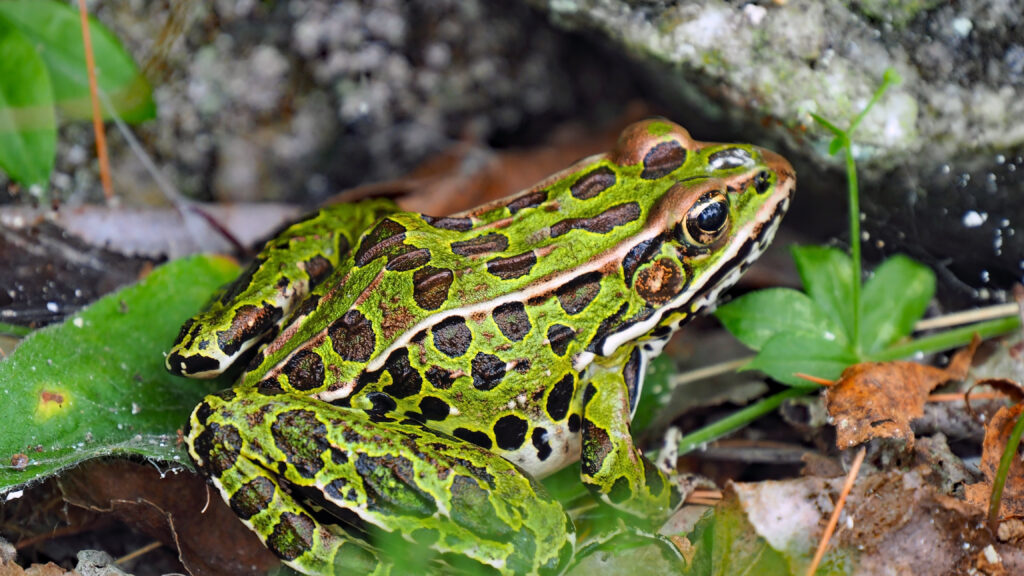
Leopard frogs get their name from their appearance, which consists of leopard like spots over their entire body. They will typically eat insects along with invertebrates such as leeches and larvae. Leopard frogs hibernate underwater during the winter in order to survive cold temperatures.
Toad
A toad is a type of frog that has dry, warty skin. While toads spend a lot of time in wooded and grassy areas, they often breed in the spring in lakes and ponds. Toads primarily eat snails, slugs and other invertebrates. Toads can live to be 10 to 12 years old.
Salamander
There are many different species of salamanders, and some are often found around water. They often feed on spiders, worms, and snails. Some larger salamanders may also feed on crayfish and fish. Salamanders need to keep their skin cool and wet in order to survive. Due to loss of habitat, salamanders are still considered threatened.
Snail
There are a variety of different snails with some living primarily underwater. Snails can have different shell sizes, shapes, and colors. Snails have a large foot that they use to slide along surfaces and can retract back into their shells for defense.
Leech
Leeches are small, segmented worms that are usually brown or black in color. Some leeches are predatory and will eat small prey while others are parasites that only consume blood. Most leeches commonly range in between ½ inch to 2 inches in length. Leeches can release an enzyme that prevents its hosts blood from clotting. They can also release an anesthetic to numb the bite area, so the host doesn’t feel it.
Worm
There can be a variety of different types of worms including some that live in the water. Many of these worms are a food source for a variety of other fish and other animals in lakes. They can often live in very harsh conditions and even poor water quality.
Clam
Clams are invertebrates and can be made up of many different species. Clams typically don’t move much and will keep their shells closed much of the time. People often mistake them for being dead for this reason, but most of the time they are very much alive. Clams like sand or silt lake floors to bury themselves in.
Crayfish
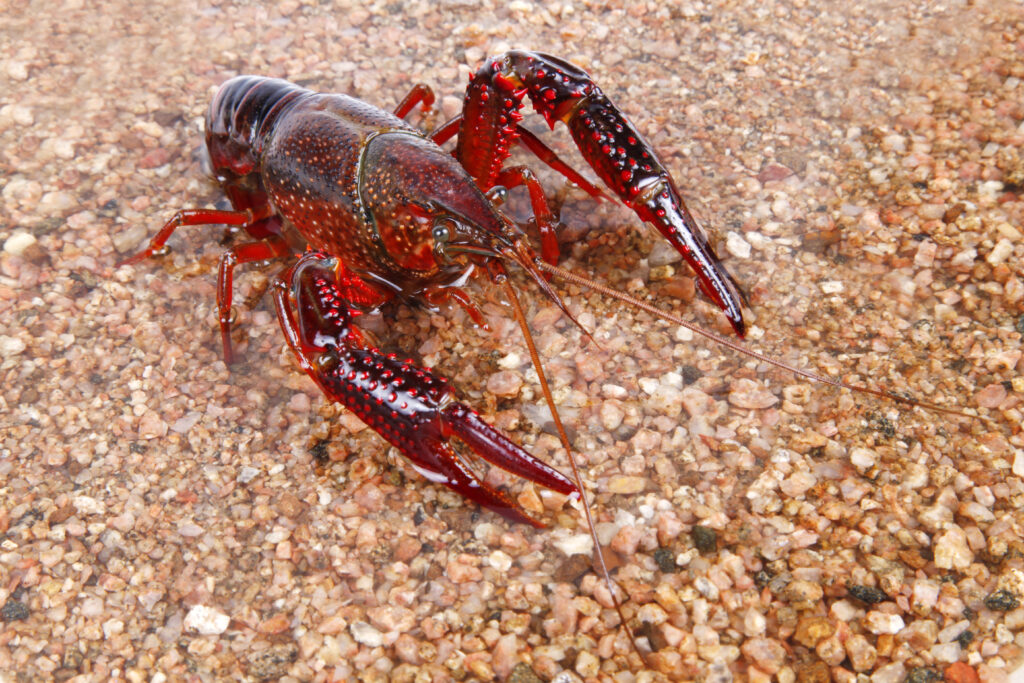
Crayfish can also be known as crawfish or crawdads depending on which part of the country you’re from. Crayfish are crustaceans that resemble small lobsters. Many people enjoy the taste of crayfish, and they make their way onto many dinner plates. They will eat a variety of different things ranging from aquatic vegetation to worms and fish.
Crab
There are a variety of freshwater crab species that occupy rivers and lakes. They can breathe on land as long as they stay moist. These crabs are important to many ecosystems and serve as an excellent food source for animals such as herons.
Zebra Mussel
Zebra mussels are a small striped mussel about the size of a quarter. Zebra mussels are considered an invasive species in the United States. They spread rapidly and cause many ecological issues. They are known to clog water intakes and reduce available food for other aquatic animals.
Freshwater Shrimp
Freshwater shrimp are small invertebrates that typically like shallow water. They typically only grow up to a few centimeters long. Freshwater shrimp thrive in lakes that have clean water, immense aquatic plant life, and low predator counts. They are a great source of food for many other aquatic animals.
Ducks
There are a variety of different duck species with the most common being the mallard duck. Ducks are divided into two categories: Divers and Dabblers. Divers are species that will dive beneath the water surface to hunt for food while dabblers may dunk their head but won’t go completely underwater. Ducks are a migratory bird with some known to fly up to 800 miles in a single day.
Coot
Coots are birds that greatly resemble ducks. They are dark feathered with white beaks. Coots primarily eat plant material although they do also eat insects sometimes. They will usually lay their eggs in floating nests right on the water.
Geese
Geese are also a migratory bird. Geese are a very social animal and have been known to bond to each other as well as humans. There are a variety of different species with one of the most common being the Canada goose. Geese fly in a v formation, which helps reduce wind resistance and make flying easier.
Swan
Swans are known for their beauty and large size. In fact, they are the largest native waterfowl species in North America. They can weigh up to 30 pounds and can have a wingspan of 10 feet. Swans can range in size and color depending on the species. Trumpeter swans are known for their extremely loud, trumpet like call.
Great Blue Heron

Great blue herons are gray in color and have a long beak used to catch fish. Great blue herons are large birds that are known for their long legs. They use these long legs to wade into water and hunt for fish. Great blue herons are masters at standing extremely still while canvasing the water for fish.
Green Heron
Green herons are a small species of heron. They have unique colors including a dull green color on its back along with a chestnut-colored front side and neck. They are one of the few species known to use objects to catch fish. They will drop feathers and twigs on the waters surface and wait for a fish to investigate the object. When the fish comes in close they strike with their long beak.
Egret
Egrets are members of the heron family and closely resemble a great blue heron in size and body style. They are typically white in color with a yellow beak. They have long legs used for wading into water to hunt fish and a long beak for spearing.
Common Loon
Loons may be most known for their calls. They have very distinct, almost eerie calls that many people find fascinating. Loons typically weigh between 5 and 15 pounds. Loons have dense bones that help them dive and swim underwater to catch their prey.
Sandpiper
Sandpipers are a small bird that can normally be found along the shores or shallow waters. They will walk along and pick at the mud and sand looking for food. They have long legs that allow them to wade into shallow water while searching for food. Sandpipers will primarily feed on small invertebrates like clams, snails, and insects.
Pelican
Pelicans are a unique animal that dates to 30 million years ago. They are a large bird that can grow to be 4 foot tall and have a 9-foot wingspan. They can be a variety of different colors depending on species. They have webbed feet that allow them to propel themselves easily in water.
Snapping Turtle
Snapping turtles are known for their powerful snap-like bite and aggressive nature. They have a pointed beak and an incredible bite strength that can inflict extreme damage on its target. Snapping turtles can weigh up to 50 pounds and reach ages over 40 years old.
Painted Turtle

Painted turtles get their name from some of their brilliant colors that stripe their head and shell. Their shell is very smooth with hints of colors mixed amongst its greenish brown base. Painted turtles are the most commonly found turtle in North America and often kept as pets.
Water Snake
There are a variety of different water snakes you may see, most of them being non-venomous. Water snakes can look very different when on land in comparison to water. This is because as their scales dry, it can be more difficult to see their markings and colors. Water snakes feed primarily on fish and frogs, swallowing its prey whole.
Alligator
Alligators can grow up to 12 feet long and weigh an incredible 1000 pounds. Alligators can live up to 50 years in the wild. They’re primarily found in southern states such as Florida and Louisiana in the United States. Alligators can swim up to 20 miles per hour.
Crocodile
Many people struggle to tell crocodiles apart from alligators. One way to tell is by looking at their mouth when closed. A crocodile will have all its teeth visible when its mouth is closed, whereas an alligator will only be showing its top teeth. A crocodile possesses the strongest bite strength of any animal and is often more aggressive than alligators.
Beetle
There are many types of water beetles with one of the most common being the diving beetle. Some water beetles still possess wings and are able to fly. They will hide in the aquatic vegetation from predators. They also possess a hard, armor-like shell that shields them from attacks.
Dragonfly
There are over 5000 species of dragonflies, and you’ll often find them landing on vegetation on lakes. They have wingspans of 2 to 5 inches but used to be much larger. There have been fossils found that show they used to have up to 2-foot wingspan thousands or even millions of years ago. Most dragonflies have a relatively short lifespan, usually living less than a year.
Giant Water Bug
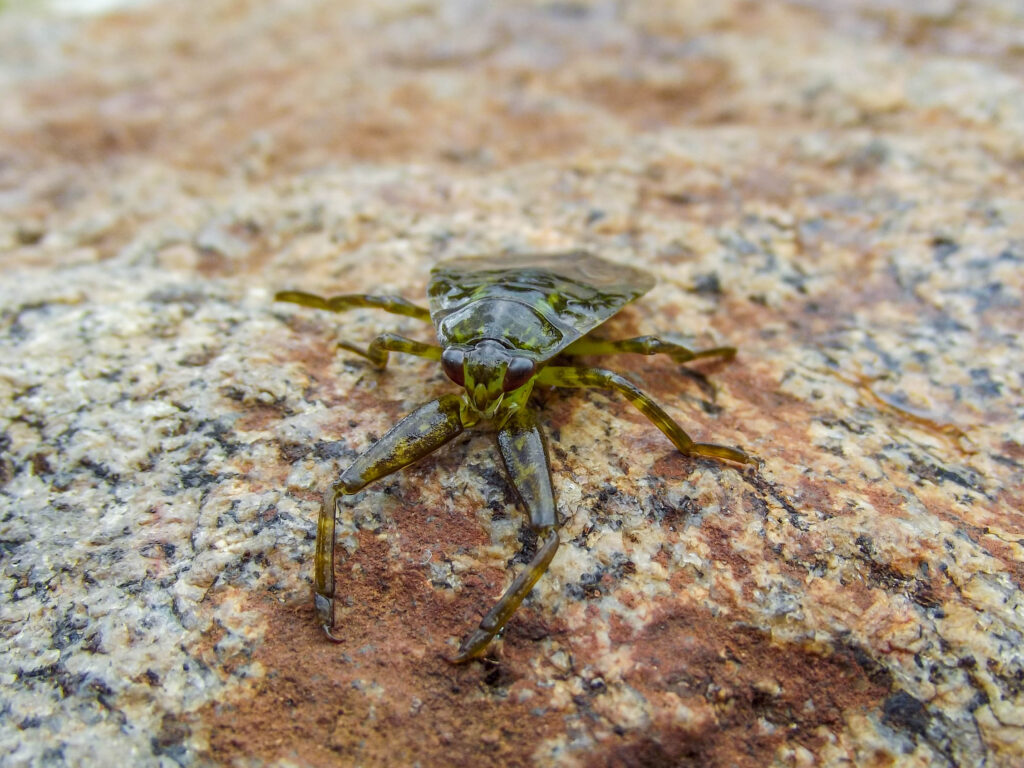
There are a variety of species of giant water bugs with the largest getting up to 4.5 inches long. They are oval shaped with large front pinchers that are used to grab its prey. One unique thing about giant water bugs is that the males carry the eggs instead of females. Giant water bugs can also play dead when feeling threatened.
Water Strider
Water striders are small insects that get their name from their ability to stride on top of the water. They can be seen on calm waters using the water tension to walk on top. They also have tiny hairs on their legs that help hold air and repel water.
Mosquito
Mosquitos are insects most people are familiar with. If you spend any time outdoors, you likely know how big of a pest they can be. Not only are they a pest but they are the deadliest creature on the planet. Mosquitos carry a variety of different diseases and it’s estimated that they kill over 1 million people every year. Mosquitos are often found near water because that is where they reproduce and lay their eggs.
Mayfly
Mayflies are flying aquatic insects that are typically green in color. The females lay thousands of eggs on the waters surface. They then hatch into larva where they stay underwater until developing into its adult flying form. This makes them an important food source for other aquatic animals. The mayfly’s lifespan is incredibly short, usually only lasting weeks or a few months.
Minnows
Minnows are a common name for variety of small fish that make up about 1600 species. They often swim in groups and eat insects and vegetation. Minnows fall prey to many fish species and are often used as bait for fisherman.
Bass
There are a variety of different species of bass with the most known probably being the largemouth bass. Bass are often sought after by sport fisherman. They are the most popular sport fish and there are many bass tournaments throughout the country. The world record for largemouth bass is currently 22 pounds 4 ounces.
Catfish
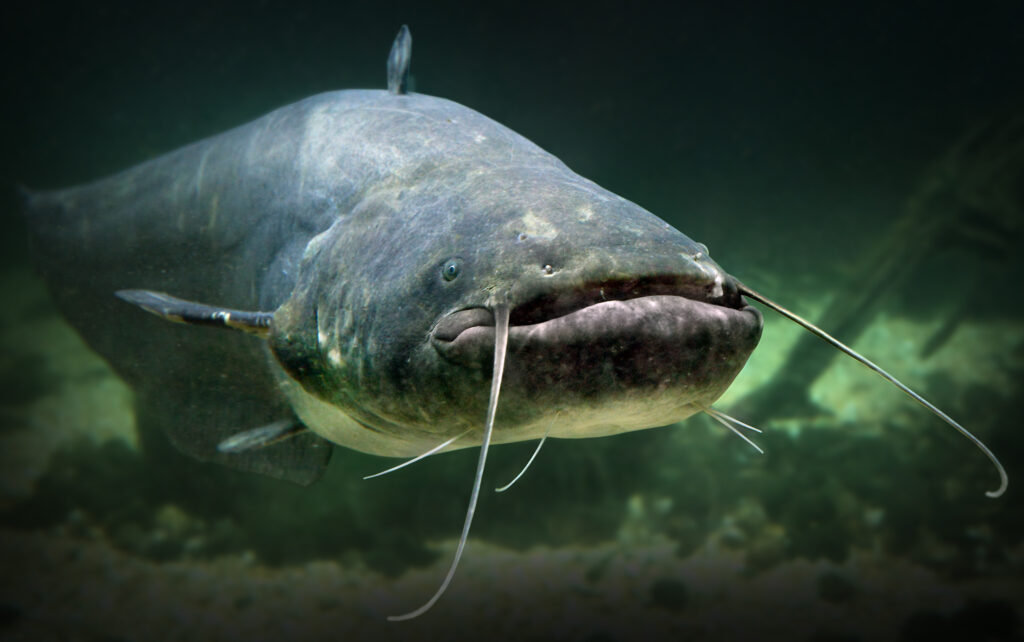
There are a variety of different species of catfish with the most common two being the channel catfish and blue catfish. Catfish get their name from their whisker like barbels on their face that they use to help locate food. The largest catfish ever caught was a Mekong catfish and weighed an impressive 646 pounds.
Redear Sunfish
The Redear sunfish gets its name from its red edge on its ear flap. Males are the only ones that possess this red color, while the females have an orange like color. They also have another nickname, shellcracker, given because of its unique teeth that allow them to crush their food with ease.
Bluegill
The bluegill is another fish in the sunfish family. They get their name from the blueish region around their gill cover. Bluegill often feed on aquatic insects and smaller fish. They often fall prey themselves to larger predatory fish such as bass.
Walleye
Walleyes are long thin fish belonging to the perch family. They get their name from their white glossy eyes that allow them to see better in murky waters. This allows them to be excellent hunters. The length on the world record walleye is 41 inches.
Crappie
Crappie are one of the most popular sunfish. This is because they are fun to catch, especially when they are spawning. They can be very aggressive and put up an impressive fight for their size. They are also a little larger than some of the other sunfish, so they bare a little more meat for fishermen who target them for food.
Salmon
There are a variety of different types of salmon. Chances are, if you like to eat fish, you’ve probably had salmon at some point. Their meat is bright orange to red in color and very flavorful. Salmon are known to be essential species in certain ecosystems around the world, providing food and nutrients to the entire ecosystem.
Trout
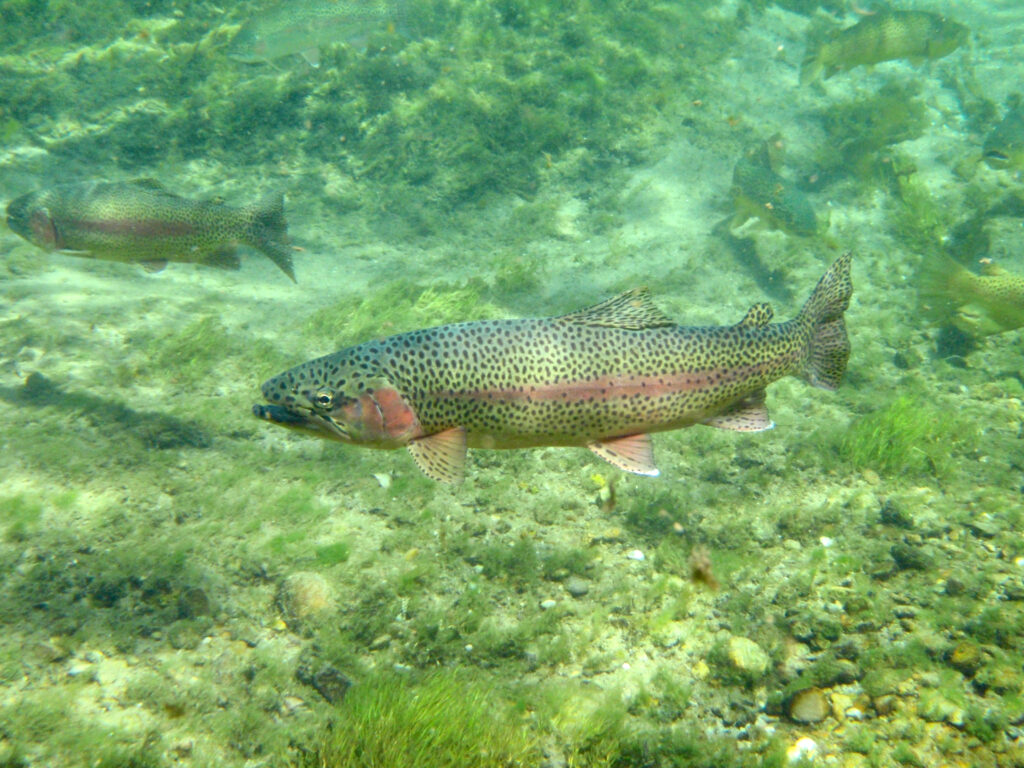
There are many species of trout, with one of the most recognizable being the rainbow trout. The rainbow trout is very colorful and vibrant, which is where its name comes from. Some other species of trout include cutthroat, golden, brook, speckled, brown, and lake trout.
Carp
The carp is native to Asia however, it has become widespread across the world and is considered the most invasive fish species. They were often introduced to new areas in hopes of controlling pests and vegetation, but quickly became a problem themselves. They can take food away from native fish and damage habitat.
Perch
There are many different species of perch, many of which are named after physical appearances and color, such as yellow, golden, and silver. Perch are another common sport fishing species, although they are also commercially farmed for food in some locations.
Northern Pike
Northern pike are unique looking fish with a mouthful of sharp teeth. They can grow very long and are able to swim up to 10 mph. They are a carnivorous fish and experts at hiding from prey before striking. The current world record for northern pike is 55 pounds.
Gar
Gars almost look prehistoric and for good reason, they date back to over 150 million years ago! The alligator gar is the largest of the gar species, growing up to 10 feet in length. Gar are opportunistic hunters mainly because they are rather slow when compared to other fish. They will typically eat whatever fish and invertebrates come close enough to snatch by just moving their head.
Muskellunge “Musky”
Muskellunge fish are another large predatory fish. They are a cousin to northern pike and share many of the same traits, including their aggressive nature. Muskellunge will grow larger than northern pike, with the record weighing 65 pounds.
Sturgeon
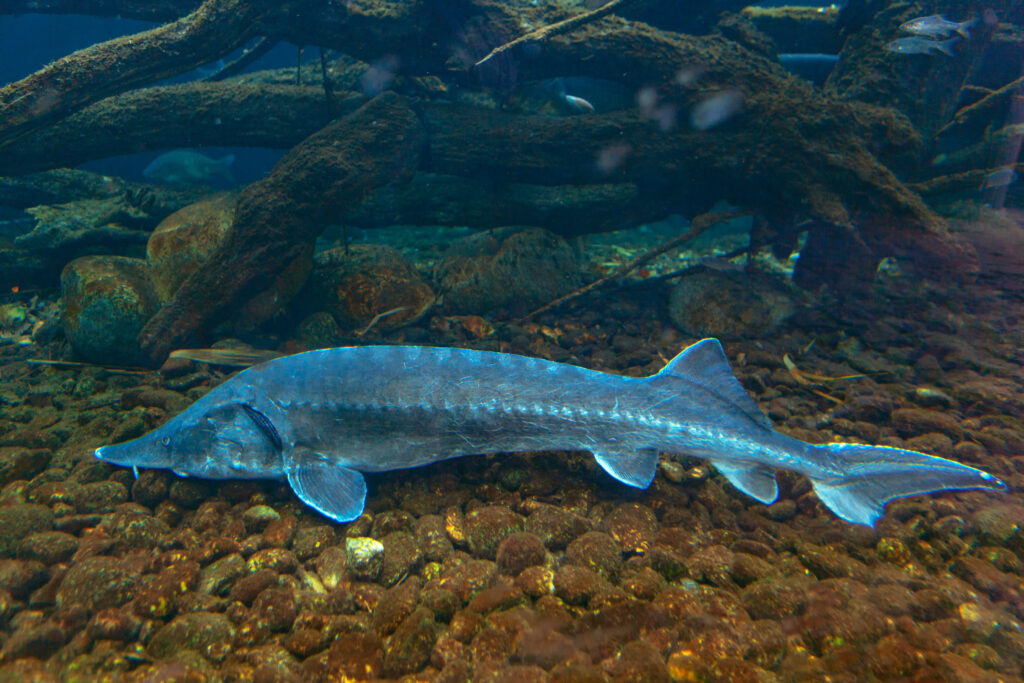
Sturgeons are another large prehistoric fish that date back to 170 million years ago. Sturgeons are heavily fished for the caviar market. Many species of sturgeon are listed as endangered due to overfishing. In fact, sturgeons are considered the most endangered group of animals.
Eel
Eels are snake like fish that don’t have any scales. They prefer shallow waters, and most are nocturnal. Eels swim in a unique way by generating waves in their body which allows them to propel in the water. They can go backwards by reversing the direction of the waves in their bodies.
Sculpin
Sculpins are small fish with a wide head and eyes on the top portion. There are 300 species of sculpin with most measuring less than 5 inches. Sculpins do not possess a very tasteful meat, which is why they are rarely ever eaten.
- What Do Squirrels Eat? Learn About Their Diet and Winter Survival - October 14, 2024
- What Do Raccoons Eat? Discover Their Diet and Eating Habits - October 6, 2024
- What do foxes eat? - October 5, 2024

